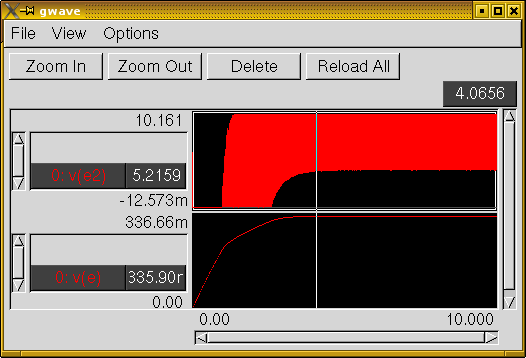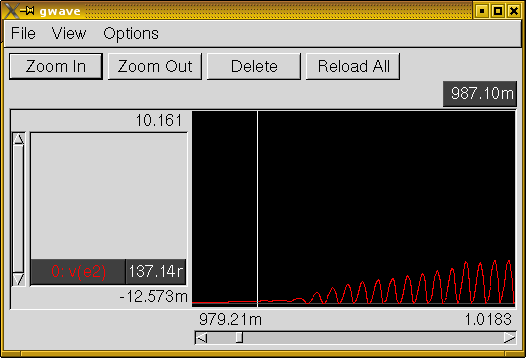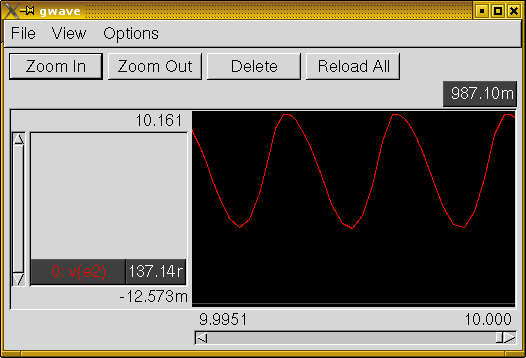Phase shift oscillator
Getting started
In this example, we will analyze a phase shift oscillator. It was designed in a hurry, so the specs are not expected to be very good. We will see.
It uses a single BJT, plus an emitter follower, and runs on a single-ended 12 volt supply.
Some measurements might include:
- Oscillation frequency
- Start-up time (how long it takes to stabilize)
- Distortion
Of course, we will look at the waveform.
I did this on the 2008-07-07 development snapshot, using some new features. I am not showing some of the mistake and trial steps, so your results may be a little different.
I am using an external waveform viewer “gwave” to display the waveforms.
That's enough for now, let's go…
The circuit
Here's a netlist for the circuit:
' phase shift oscillator .model npn npn bf=100 Vcc (vcc 0) pulse(iv=0 pv=12 rise=.01) Rb1 (vcc b) 100k Rb2 (b 0) 10k Rc (vcc c) 10k Re (e 0) 1k Ce (e 0) 5000u Re2 (e2 0) 1k Q1 (c b e) npn Q2 (vcc c e2) npn C1 (e2 f1) .01u C2 (f1 f2) .01u C3 (f2 b) .01u Rf1 (f1 0) 10k Rf2 (f2 0) 10k
There are some tricks here ..
First, the power supply (Vcc). It is a voltage source, but instead of just saying “DC=12” to make it a constant 12 volt supply, I made it a pulse. It starts at zero, and waits until time=.01 to switch on. I did this because I want to see how it starts.
With just plain “DC=12” it would still oscillate, but I cannot be sure of the actual start waveform. For one, the emitter bypass would already be charged.
Next, I used a simple model of the BJT, specifying only the beta.
The emitter bypass gives a time constant of 5 seconds, which should make the start-up nice and slow.
Finally, to show some contempt for good design, I just picked R and C for the filter arbitrarily, with no real idea what the frequency would be.
Setting up
Run it interactively …
$$$$$$$gnucap Gnucap 2008.07.07 RCS 26.86 The Gnu Circuit Analysis Package Never trust any version less than 1.0 Copyright 1982-2007, Albert Davis Gnucap comes with ABSOLUTELY NO WARRANTY This is free software, and you are welcome to redistribute it under the terms of the GNU General Public License, version 3 or later. See the file "COPYING" for details. gnucap> get pso.ckt ' phase shift oscillator
Load the circuit .. it echos the title line.
As a check, list it, see if it is what you expected.
gnucap> list .model npn npn ( level=1 kf=NA( 0.) af=NA( 1.) bf= 100. br=NA( 1.) is=NA( 100.E-18) nf=NA( 1.) nr=NA( 1.) isc=NA( 0.) re=NA( 0.) rc=NA( 0.) cjc=NA( 0.) cje=NA( 0.) cjs=NA( 0.) fc=NA( 0.5) mjc=NA( 0.33) mje=NA( 0.33) mjs=NA( 0.) tf=NA( 0.) tr=NA( 0.) xtf=NA( 0.) xtb=NA( 0.) xti=NA( 3.) eg=NA( 1.11)) Vcc ( vcc 0 ) pulse iv= 0. pv= 12. delay=NA( 0.) rise= 0.01 fall=NA( 0.) width=NA( Inf) period=NA( Inf) Rb1 ( vcc b ) 100.K Rb2 ( b 0 ) 10.K Rc ( vcc c ) 10.K Re ( e 0 ) 1.K Ce ( e 0 ) 0.005 Re2 ( e2 0 ) 1.K Q1 ( c b e ) npn NA( 1.) Q2 ( vcc c e2 ) npn NA( 1.) C1 ( e2 f1 ) 10.n C2 ( f1 f2 ) 10.n C3 ( f2 b ) 10.n Rf1 ( f1 0 ) 10.K Rf2 ( f2 0 ) 10.K
Looks good .. note the “NA” fields …. NA(5) means that the value is unspecified, but assumed to be 5. You can see what parameters were specified, and which took the defaults.
Before making a run, you need to set a few things up …
Pick the points you want to view (all node voltages):
gnucap> print tran v(nodes)
Pick the points you want to be able to do things like “measure” on (all probes named “v” on anything, including nodes, devices, etc):
gnucap> store tran v(*)
Now, check the options. We may want to change some:
gnucap> opt .options noacct nolist mod nopage nonode noopts gmin= 1.p reltol= 0.001 abstol= 1.p vntol= 1.u trtol= 7 0 limtim=2 limpts=201 lvlcod=2 lvltim=2 method=trap maxord=2 itl1=100 itl2=50 itl3=6 itl4=20 itl5=5000 er dampmax= 1. dampmin= 0.5 dampstrategy=0 floor= 1.E-21 vfloor= 1.f roundofftol= 100.f temperature= 27. s ansits=2 nodupcheck bypass incmode lcbypass lubypass fbbypass traceload itermin=1 vmax= 5. vmin=-5. dtm old= 1.E+99 trstepshrink= 2. trreject= 0.5 trsteporder=3 trstepcoef1= 0.25 trstepcoef2= 0.04166667 trstepcoe units=spice
The only one I will change now is the printing precision .. Set it to 8 digits. Starting an oscillator takes a long time.
gnucap> opt numdgt=8
Get started, run to steady state
For starters, let's run it for 10 seconds, with a trial time step of .01. “trace all” says to output all of the internal time steps too. Otherwise, you will just get the ones you asked for.
I directed it to a file, boringly called “z”. Then look at it with “gwave”. The bang (!) says to run a command through the shell. The ampersand (&) says to leave it running and return, just like a shell command. That way we can keep the waveforms on the screen and keep going.
gnucap> tran 0 10 .01 trace all >z gnucap> !gwave z &
Here's the waveform. It looks like it doesn't start oscillating until about 1 second. Then takes until about 5 seconds to settle. It looks like 10 seconds was a good guess.
Here's an expanded view just as it starts to oscillate:
The last few cycles at the end of the run:
The measurements we want
Now, tighten the tolerance, so we can get good measurements. The default settings are fine most of the time, but for this we need better.
See what they are:
gnucap> opt .options noacct nolist mod nopage nonode noopts gmin= 1.p reltol= 0.001 abstol= 1.p vntol= 1.u trtol= 7. chgtol= 10.f pivtol= 100.f pivrel= 0.001 numdgt=8 tnom= 27. cptime=30000 limtim=2 limpts=201 lvlcod=2 lvltim=2 method=trap maxord=2 itl1=100 itl2=50 itl3=6 itl4=20 itl5=5000 itl6=0 itl7=1 itl8=99 defl= 100.u defw= 100.u defad= 0. defas= 0. clobber dampmax= 1. dampmin= 0.5 dampstrategy=0 floor= 1.E-21 vfloor= 1.f roundofftol= 100.f temperature= 27. short= 10.u out=9999 ydivisions= 4. phase=degrees order=auto mode=mixed transits=2 nodupcheck bypass incmode lcbypass lubypass fbbypass traceload itermin=1 vmax= 5. vmin=-5. dtmin= 1.p dtratio= 1.G rstray cstray harmonics=9 trstepgrow= 1.E+99 trstephold= 1.E+99 trstepshrink= 2. trreject= 0.5 trsteporder=3 trstepcoef1= 0.25 trstepcoef2= 0.04166667 trstepcoef3= 0.005208333 noquitconvfail edit recursion=20 language=acs insensitive units=spice
Now tighten “reltol” and “trtol”.
gnucap> opt reltol=.0001 trtol=1
and run for another .01 seconds, continuing…
gnucap> tran 10.01 .001 trace all >z gnucap> !gwave z &
and make some measurements…
gnucap> measure t2=cross("v(e2)", cross=7, rise, last)
t2= 10.00943
gnucap> measure t1=cross("v(e2)", cross=7, rise, last, before=t2)
t1= 10.00778
gnucap> param frequency={1/(t2-t1)}
gnucap> eval frequency
frequency= 606.060606060714
For the Fourier analysis, pick a fundamental of half of the real fundamental, as an indicator of accuracy. We all know, there should be nothing there. If the component at the odd frequencies is too big, it means the frequency we specified is slightly in error, and we need to tighten tolerances and fine tune.
gnucap> eval frequency/2 (frequency / 2)= 303.030303030357 gnucap> print fourier v(e2) gnucap> fourier 0 10k 303.030303030357 #Time v(e2) 10.0133 8.9974012 10.013326 8.7969959 10.013352 8.5847199
10.016574 9.0517243 10.0166 8.8549586 # v(e2) --------- actual --------- -------- relative -------- #freq value dB phase value dB phase 0. 7.0656 16.98 90.000 2.2861 7.18 -44.748 303.03 0.034076 -29.35 118.607 0.011025 -39.15 -16.141 606.06 3.0907 9.80 134.748 1. 0.00 0.000 909.09 0.040746 -27.80 -43.182 0.013183 -37.60 -177.930 1.2121K 0.3894 -8.19 -94.915 0.12599 -17.99 130.337 1.5152K 0.017954 -34.92 17.761 0.0058088 -44.72 -116.987 1.8182K 0.15704 -16.08 4.083 0.05081 -25.88 -130.665 2.1212K 0.0042367 -47.46 67.220 0.0013708 -57.26 -67.528 2.4242K 0.079307 -22.01 94.762 0.02566 -31.82 -39.986
303 Hz has a relative amplitude of -39 db. Not very good.
Tighten the tolerances and measure again:
gnucap> opt reltol=.00001 trtol=1
gnucap> tran 10.01 .001 trace all >z
gnucap> measure t2=cross("v(e2)", cross=7, rise, last)
t2= Inf
Error …. we already went past 10.01 seconds .. Move ahead and try again.
gnucap> tran 10.03 .001 trace all >z
gnucap> !gwave z &
gnucap> measure t2=cross("v(e2)", cross=7, rise, last)
t2= 10.02911
gnucap> measure t1=cross("v(e2)", cross=7, rise, last, before=t2)
t1= 10.02747
gnucap> eval frequency/2
(frequency / 2)= 304.878048780472
gnucap> eval frequency
frequency= 609.756097560944
gnucap> fourier 0 10k 304.878048780472
#Time v(e2)
10.029986 6.3978311
10.030012 6.1507251
10.030037 5.9090503
10.033189 7.1588976 10.033215 6.9059126 10.03324 6.6531773 10.033266 6.4023893 # v(e2) --------- actual --------- -------- relative -------- #freq value dB phase value dB phase 0. 7.0581 16.97 90.000 2.2836 7.17 -104.675 304.88 256.82u -71.81 -1.240 83.092u -81.61 164.086 609.76 3.0908 9.80 -165.325 1. 0.00 0.000 914.63 0.0011098 -59.09 -171.143 359.08u -68.90 -5.817 1.2195K 0.38362 -8.32 21.927 0.12412 -18.12 -172.748 1.5244K 103.52u -79.70 178.156 33.493u -89.50 -16.518 1.8293K 0.14832 -16.58 -177.459 0.047988 -26.38 -12.133 2.1341K 357.2u -68.94 -179.519 115.57u -78.74 -14.193 2.439K 0.079273 -22.02 -23.966 0.025648 -31.82 141.360 2.7439K 132.94u -77.53 -126.976 43.011u -87.33 38.350 3.0488K 0.049584 -26.09 126.722 0.016043 -35.89 -67.952 3.3537K 168.29u -75.48 163.828 54.45u -85.28 -30.847 3.6585K 0.033637 -29.46 -84.750 0.010883 -39.27 80.575 3.9634K 163.24u -75.74 -138.899 52.816u -85.54 26.426 4.2683K 0.024012 -32.39 63.711 0.0077689 -42.19 -130.964 4.5732K 52.818u -85.54 168.840 17.089u -95.35 -25.834 4.878K 0.018021 -34.88 -148.890 0.0058308 -44.69 16.435
That's better. Noise is -68 db or better. 305 Hz is -81 db.
As I said, the oscillator isn't very good. The second harmonic is only 18 db below the fundamental.
Enough for now…


